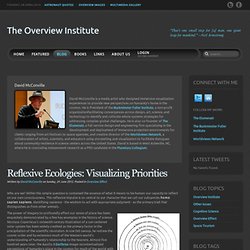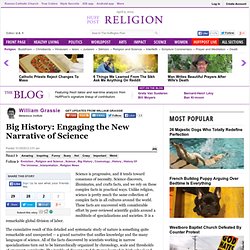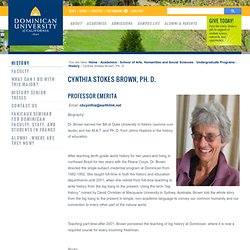

Big-History-Educator-landing-page. Kuratortool.dk. NASA Goddard Scientific Visualization Studio. David McConville - The Overview Institute. Who are we?

Within this simple question is contained the essence of what it means to be human: our capacity to reflect on our own consciousness. This reflexive impulse is so central to our character that we call our subspecies homo sapien sapiens, identifying sapience - the wisdom to act with appropriate judgment - as the primary trait that distinguishes us from other animals.
Www.collinsfoundationpress.com/EE Home.htm. William Grassie: Big History: Engaging the New Narrative of Science. Science is progressive, and it tends toward consensus of necessity.

Science discovers, illuminates, and crafts facts, and we rely on these complex facts in practical ways. Unlike religion, science is pretty much the same collection of complex facts in all cultures around the world. These facts are uncovered with considerable effort by peer-reviewed scientific guilds around a multitude of specializations and societies. It is a remarkable global division of labor. The cumulative result of this detailed and systematic study of nature is something quite remarkable and unexpected -- a grand narrative that unifies knowledge and the many languages of science.
Cynthia Stokes Brown, Ph. D. — Dominican University of California. Email: cbcynthia@earthlink.net.

Connections (TV series) ChronoZoom - Behind the scenes. Zooming In and Out of History. Technology Timeline. Computer History Museum. History of Computers, Computing and Internet. February 2012. It was presented at the International Conference on Science Communication for Scientific Temper, 10-12 January, 2012 New Delhi. Abstract From prehistoric times, humans have evolved as a pattern-seeking and storytelling species. While the capacity to find patterns and infer meanings had obvious advantages for survival, the brain is not always successful in distinguishing meaningful and meaningless patterns. In fact, “pattern finding” and “order seeking” mechanisms form the basis for nearly all existing myths, superstitions, cultural taboos and ritual practices all over the world. The same mechanism also makes us extremely vulnerable to all kinds of deceptions and manipulative techniques that impair our critical faculties.
Introduction Our grand universe was born with a ‘big-bang’ about 13.7 billion years ago. Lessons from Optical Illusions Figure 1: Lessons from optical illusions Now take a closer look at Fig. 2. Technological onslaught The information age is not free from its perils. History-bigbang.jpg (1361×919) Ancient-big-bang-one-sacred-science-spiritual-Favim.com-105731.jpg (500×265) Computer History. John Kopplin © 2002 The first computers were people!

That is, electronic computers (and the earlier mechanical computers) were given this name because they performed the work that had previously been assigned to people. "Computer" was originally a job title: it was used to describe those human beings (predominantly women) whose job it was to perform the repetitive calculations required to compute such things as navigational tables, tide charts, and planetary positions for astronomical almanacs. Imagine you had a job where hour after hour, day after day, you were to do nothing but compute multiplications.
Boredom would quickly set in, leading to carelessness, leading to mistakes. This picture shows what were known as "counting tables" [photo courtesy IBM] A typical computer operation back when computers were people. The abacus was an early aid for mathematical computations. A very old abacus A more modern abacus. An original set of Napier's Bones [photo courtesy IBM] Digital History Reader.
Preserving Digital History. Introduction In this chapter you will learn about: The perils of maintaining historical materials in digital formats What you can do right now to prevent the loss of your digital work Sound methods for constructing your website that will give it the best possible chance to survive inevitable technical changes over time What computer scientists, digital librarians, and archivists are doing to help preserve websites and other digital artifacts in the long run t the end of 2002, My History Is America’s History, an ambitious website aimed at promoting personal history among a popular audience and storing these narratives for others to read and reflect upon online, disappeared from the web with little fanfare.
Figure 43: Now that the site is defunct we can only see a small portion of what was on the national Endowment for the Humanities’ website My History is America’s History by entering its former URL in the “Wayback Machine” of the Internet Archive. Introduction. Walking Through Time. His Plan Is To Combine Art And Science To Create "Big History" - Falmouth - Communities. By: Brent Runyon Published: 07/17/12 Richard J. Blundell of Cambridge is developing a new one-man show he hopes to perform in Woods Hole this summer that combines history, science, and theater. Mr. Blundell plans to work with scientists from the Woods Hole Oceanographic Institution and a local theater director on “A Surfer’s Guide to the Universe,” which he hopes to perform in August and September. Mr. From Duxbury originally, and formerly a marine geologist with Sea Education Association in Woods Hole, Mr. His performance is part of his doctoral degree in big history at Macquarie University in Sydney, Australia, where he studies with David Christian, one of the founders of the emerging field.
Although he is technically based in Sydney, his scholarship allows him the freedom to travel wherever he wants. The one-man performance will include projected multimedia and music, similar to a TED talk. Mr. Humans are relatively recent arrivals on Earth, but play an important role in big history. Paper Machines. I have had the good fortune to work at metaLAB this summer on an open-source tool for text analysis and visualization in the digital humanities. This effort, funded through the Google Summer of Code, is taking place under the tutelage of metaLAB’s own Matthew Battles and the historian and Harvard Junior Fellow Jo Guldi, who will be joining Brown University’s faculty in the fall.